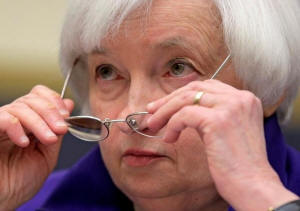|
Far from stepping back, top central banks
are set to double down
 Send a link to a friend
Send a link to a friend
 [October 10, 2016]
By Howard Schneider and Leika Kihara [October 10, 2016]
By Howard Schneider and Leika Kihara
WASHINGTON (Reuters) - Central banks'
repeated warnings that there are limits to what they can do to bolster
the sputtering world economy could suggest they are about to pull back
and pass the baton to governments.
But a steady flow of research and a new tone in the debate among
policymakers and advisers points in a different direction: rather than
retreat, central banks are preparing for the day they may need to do
more, even at the risk of antagonizing politicians who argue they
already have too much power.
The shift can be seen in the acknowledgment by Federal Reserve
policymakers that their massive $4 trillion balance sheet will not
shrink anytime soon, or that asset buying may become a "recurrent" tool
of future monetary policy. It can be seen in the comments of Bank of
England officials who talk of crisis-fighting tools as now
semi-permanent fixtures, or in the Bank of Japan developing a new
monetary policy framework, in this case targeting long-term market
interest rates.
Driving those developments is an emerging consensus among policymakers
who now acknowledge that the global financial crisis has led to a
fundamental shift toward low inflation, tepid growth, lagging
productivity and interest rates stuck near zero.
"We could be stuck in a new longer-run equilibrium characterized by
sluggish growth and recurrent reliance on unconventional monetary
policy," Fed Vice Chair Stanley Fischer said last week.

For years, Federal reserve and other policymakers have discounted such a
scenario, arguing that temporary factors were slowing the recovery and
plotting a return to conventional pre-crisis policies.
Over the past months, though, that optimism has given way to an
admission that such a return is increasingly elusive. Interest rates are
set to stay low far longer than thought only a year ago and jumbo
balance sheets accumulated through crisis-era asset purchases are now
cast as a possibly permanent tool.
At the annual Jackson Hole Fed conference in August the discussion had
shifted from the mechanics and timing of "normalization," to how and
whether to expand the central bank footprint yet again.
Policymakers still keep reminding governments they should help boost
productivity and growth with reforms and, where possible, spending on
infrastructure.
But there has been a growing recognition among central bankers that they
may not be able to simply hand the problem off, and that now is the time
to lay the groundwork for more aggressive policies that may be needed
down the road.
MORE TOOLS
Existing tools may not be enough "to deal with deep and prolonged
economic downturns," Yellen said in Jackson Hole. She has since flagged
the possibility that in a future downturn the Fed might need to start
buying private securities and not just government bonds, a step already
taken in Europe.
During last week's International Monetary Fund meeting, its officials
even challenged the decades-old consensus about the separation between
monetary and fiscal policy, suggesting central bankers should support
government infrastructure spending with low borrowing rates.
"The current low-interest environment provides an historic opportunity
to make these necessary investments," IMF managing director Christine
Lagarde said ahead of the meetings. Loose monetary policy could double
the growth impact of public spending and allow the debt burden to
actually fall, she said.
On Saturday, Bank of Japan Governor Haruhiko Kuroda said such "synergy"
was already factoring into the BOJ's plans.
"By continuing an extremely accommodative monetary policy, fiscal
stimulus could be even more effective,” Kuroda told a seminar.
[to top of second column] |

Federal Reserve Chairman Janet Yellen delivers the semi-annual
testimony on the "Federal Reserve's Supervision and Regulation of
the Financial System" before the House Financial Services Committee
in Washington, U.S., September 28, 2016. REUTERS/Joshua Roberts

The shift has been gradual, but gained momentum this year.
Two years ago, Japanese and euro zone policy rates were still above
zero, and the Fed published a policy normalization plan that said
the balance sheet would begin to decline once interest rates started
to rise. Fed forecasts at the time suggested rates would be on the
way up from 2015 onwards.
Yet the Fed has raised rates only once since then and when it did,
in December 2015, it gave a taste of things to come. The message was
that the Fed would keep its large portfolio until rate tightening
was "well under way."
POLITICAL HEAT
Analysts at the Institute of International Finance, the global
banking trade group, argued last week that any cuts to the Fed's
portfolio are now so far out in the future that it serves as a form
of fiscal support by keeping big amounts of government securities
off the market and rebating the interest to the Treasury each year.
Over the past year research at the San Francisco Fed and elsewhere
has cemented the idea that demographic trends, risk aversion, and
the diminished need for physical capital in a service economy, had
created a less dynamic world economy where it will be hard to move
policy rates much above zero. In this context, central banks' bond
holdings, negative rates or even de facto bankrolling of government
spending no longer look temporary or all that unconventional..
Still, an even larger footprint for central banks poses a political
challenge. There are legal constraints on the European Central Bank
and some German and Dutch politicians have argued the ECB has
already gone too far with its negative interest rates and bond
buying.
In the United States, Republican presidential candidate Donald Trump
has accused the Fed of propping up stock markets to help the
Democrats, and lawmakers routinely grill Fed officials about plans
to shrink the balance sheet.
Saying it will not happen until interest rates rise takes on less
meaning as the expected pace of increases slows.

Former inflation hawks like St. Louis Fed President James Bullard,
for example, no longer worry about the size of the Fed's asset
holdings.
"Five years ago I would have been saying you are taking a lot of
inflation risk," by scaling up asset purchases, Bullard said in a
Reuters interview. "There seems to be no urgency now to reduce the
size (of the Fed's balance sheet)."
(Reporting by Howard Schneider; Additional reporting by Balazs
Koranyi in Frankfurt; Editing by David Chance and Tomasz Janowski)
[© 2016 Thomson Reuters. All rights
reserved.]
Copyright 2016 Reuters. All rights reserved. This material may not be published,
broadcast, rewritten or redistributed. |